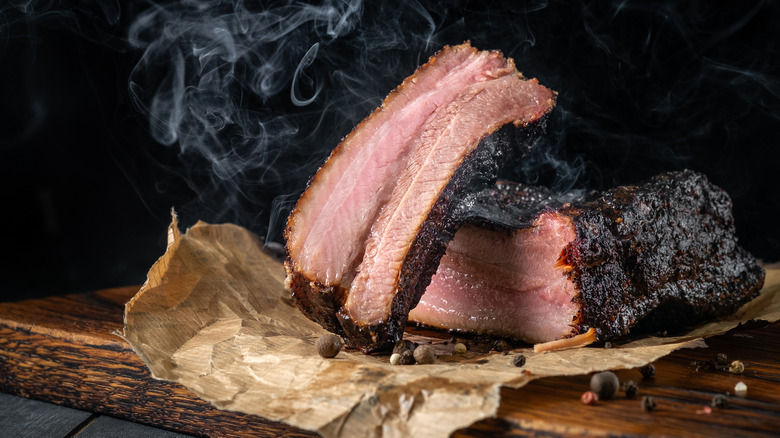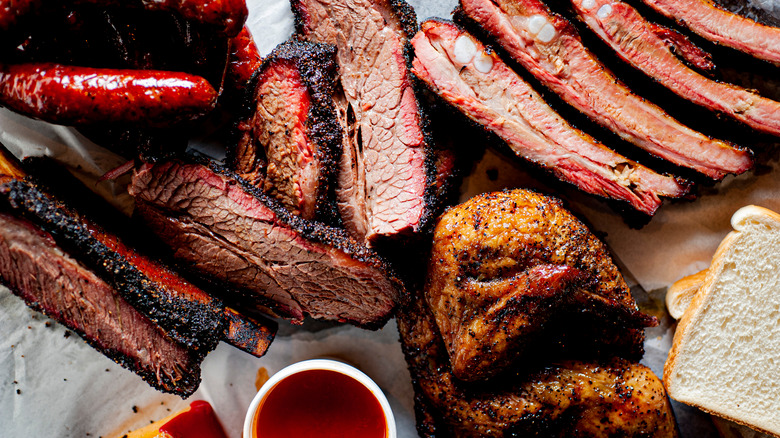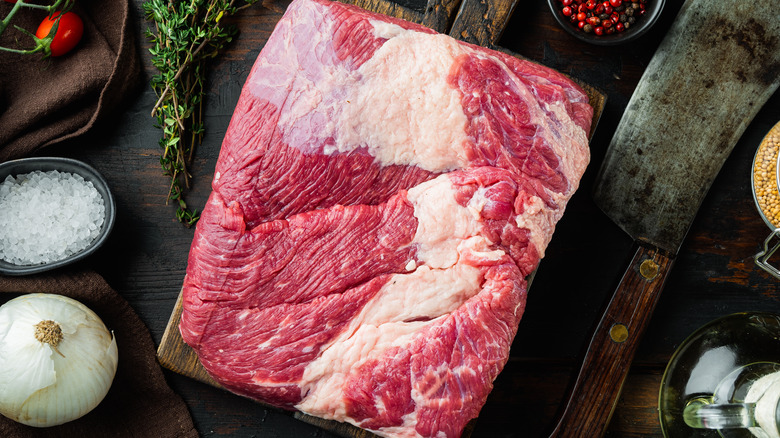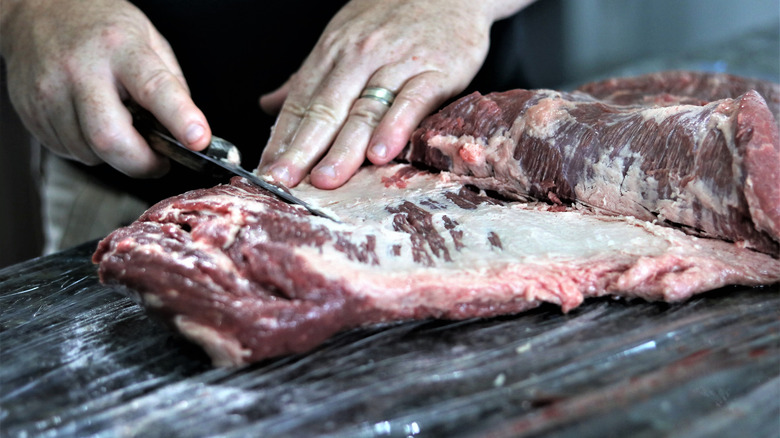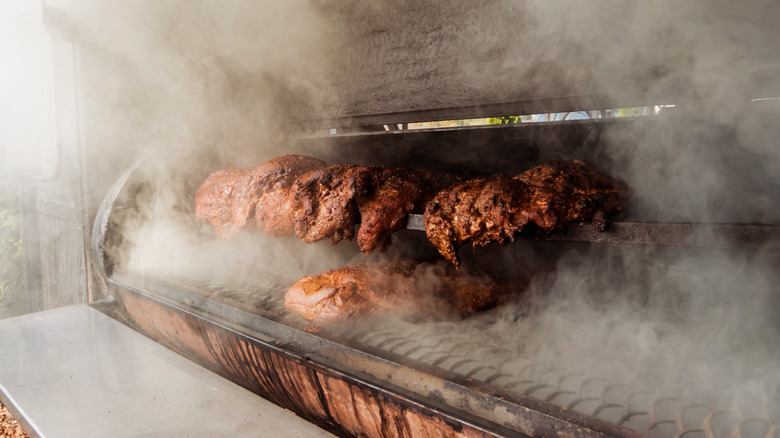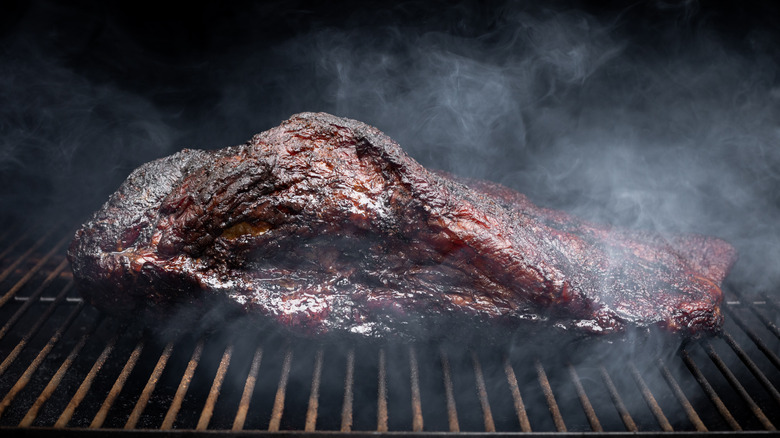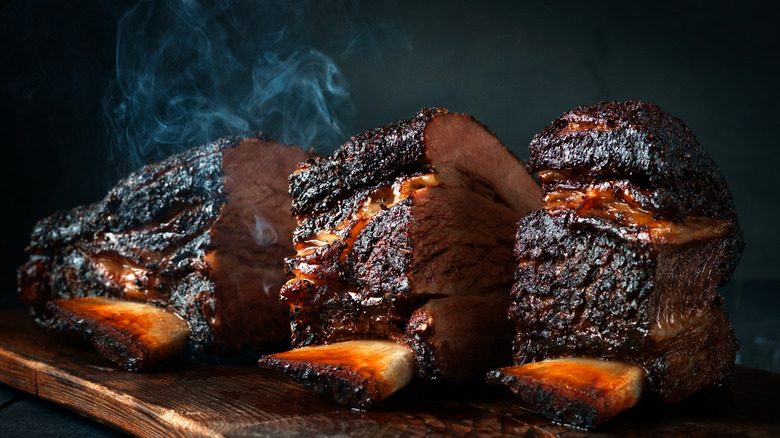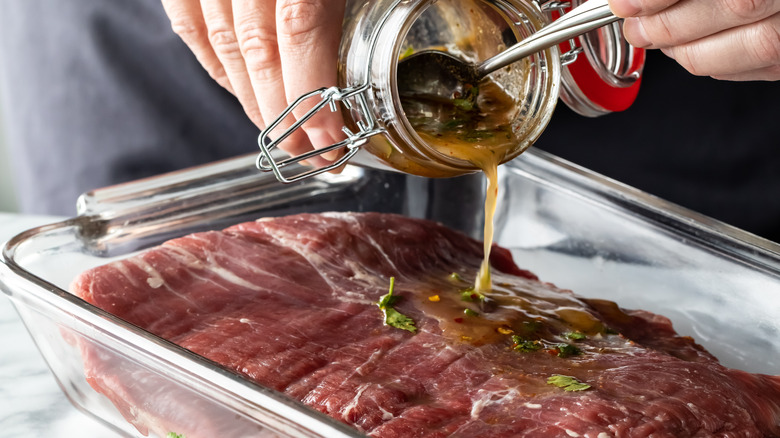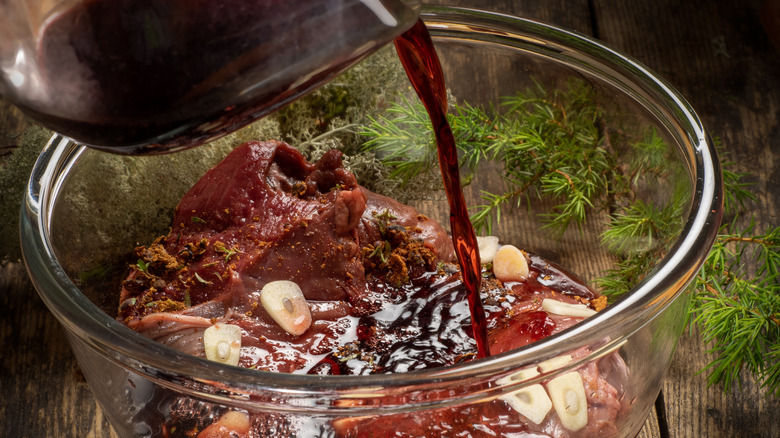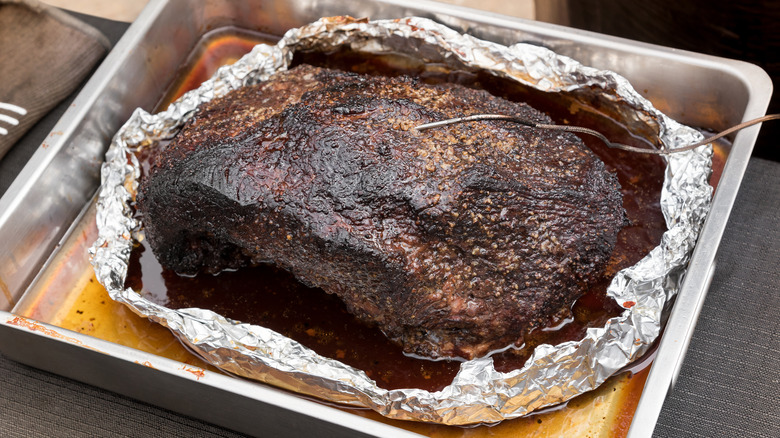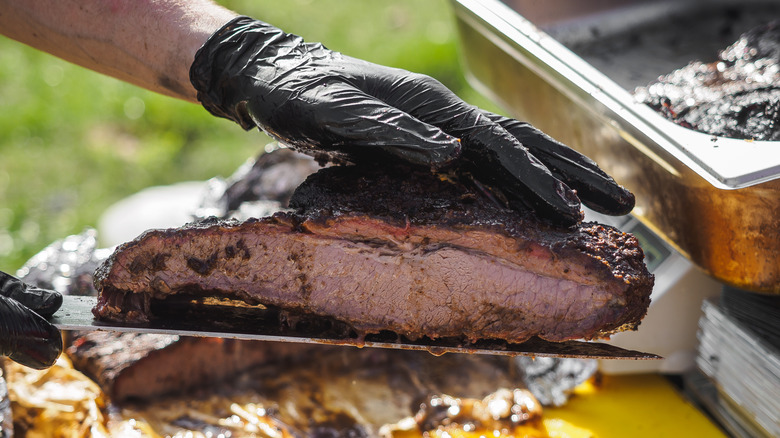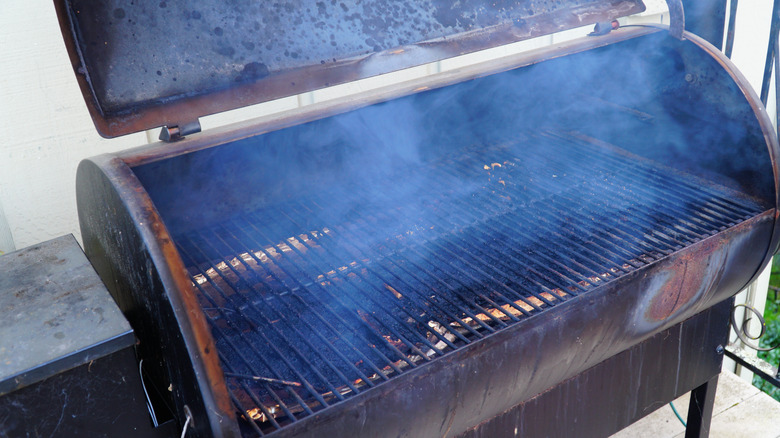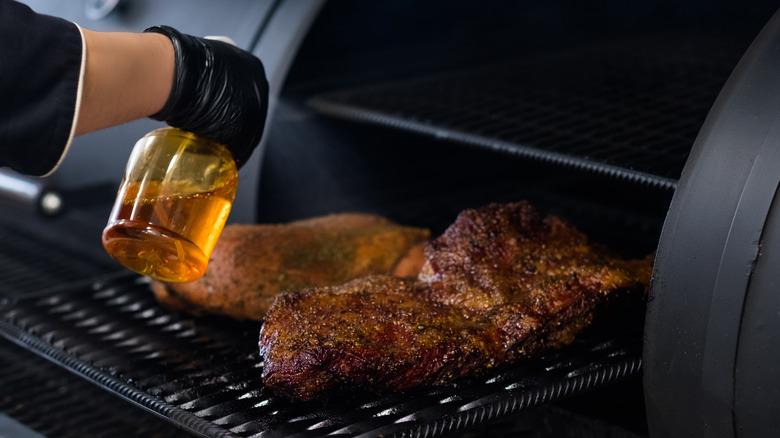The Biggest Mistakes You Need To Avoid With Brisket
Does anything represent the best season of the year (summer, of course!) better than a brisket on the smoker being slow-cooked to mouth-watering, juicy perfection? A staple of Southern cuisine and downright delicious when paired with cheesy potatoes, cole slaw, or baked beans (or all three if you're feeling adventurous ... and hungry), it's one of the best cuts of beef to prepare, especially for large gatherings. Even when the weather cools, you can feed the family (and then some) with a simple oven braised brisket.
Sadly, this hunk of beef gets a bad rep as being fickle and easily turning out chewy, tough, or dry. After all, brisket — which comes from the lower chest area of the cow — is one of the least tender cuts of beef you can get. If you're a brisket beginner, there's a chance you've been frustrated with your results. Whether you're underwhelmed with your meat's tenderness, flavor, or juiciness (or all three — we've been there) don't worry! Most brisket blunders can be corrected by avoiding these mistakes.
Buying low-quality beef
Because you're getting one of the toughest cuts of a cow right out of the gate when you opt brisket, picking low-quality meat at the counter is going to set you back. Next time you're beef shopping, be sure to scope out the USDA meat grade on the package. Try to steer clear of Standard, Commercial, and Select meat cuts, since these are going to be the leanest (and, as a result, toughest) choices due to their lower fat contents.
When choosing the perfect brisket, you're going to want some solid fat marbling to ensure your final product is tender and juicy. If you're fine with a quality that doesn't sacrifice bang-for-buck value but is still a top-shelf meat, go for Choice beef. However, if getting the tenderest, juiciest, most flavor-packed brisket is your top priority, Prime is your winner. This cut will be rich in fat marbling, which is why it's the grade recommended by the USDA as best for grilling/smoking.
Choosing a poorly butchered brisket
Fat, fat, fat: It's your number-one priority when shopping for a brisket. This cut of beef relies on its marbling for maximized tenderness and juiciness after smoking; while it cooks, the brisket's fat will melt and seep back into the meat, adding moisture and delicious smoky flavor.
A brisket will have one side entirely covered with fat. This side (the one that's rubbery and white — which is the fat from the chest of the cow) is called the fat cap. A good brisket will have a smooth, uninterrupted cap, meaning little to no cracks, scrapes or dings in the fat. Ideally, you will not see any red meat through the fat cap, and a good cap will be at around one inch thick (via Traeger).
Leaving the store with a bad brisket cut is setting yourself up for a dry, chewy chunk of meat. To be sure that you're getting a nice, fatty brisket, you can ask the butcher if they have meat that was not trimmed at all beforehand.
Over-trimming your brisket fat
Alright, so now you're home with your beef. Avoid the urge to slap that bad boy down on a cutting board and go to town removing the fat. Trimming a brisket requires a gentle hand. Over do it, and you're likely to create a dry brisket due to less fat rendering. As superstar pitmaster Aaron Franklin explains, the shape that you trim your brisket into is important (via MasterClass). If you leave pieces of meat that are too thin or protruding, they will dry out. Your brisket should be put on the smoker looking curvy and smooth rather than boxy and angled. If you're unsure, you can map out the areas you plan to trim by scoring the fat with shallow cuts. Better to leave an unnecessary nick in the surface rather than go full-fledged Fruit Ninja on your brisket!
Consider brisket trimming the same way you'd consider carpentry: measure twice and cut once. Experts recommend cutting the fat cap to no thinner than a quarter of an inch in width (via BarbecueFAQ). Keep in mind that, if you don't cut off enough fat before cooking, you can always remove more when it's done, but there's no adding fat that's gotten the chop.
Not using a smoker
We all know that just because you can do something doesn't mean you should do something, right? The same applies to cooking a brisket. Meat will, of course, be cooked by any heat source, but if you have a smoker available to you, it's the best way to go. Ovens and charcoal grills will certainly cook the meat but won't maximize it. A slow burn, however, will result in optimal tenderness and texture for this fickle cut. Brisket needs to be cooked for a long time for its fats and collagens to be broken down, but too much cooking can become a double-edged sword and dry out the beef. That is why smoking is the method of choice for brisket; the low-temp and indirect heat can be used over a long period of time to dissolve those collagens without in turn drying out the meat (via Smoking Meat Geeks).
You'll also reap the gorgeously deep, rich flavor that smoked meats are known for and that other methods such as charcoal grills and Dutch ovens just can't provide. Be sure to load your smoker with your favorite wood or pellets, too — the pitmasters over at Traeger recommend pecan, mesquite, or hickory.
Not adding moisture in your smoker
So we've established by now that preserving the moisture in a brisket is priority numero uno. However, some moisture loss is going to be inevitable; that's just part of the meat cooking process. You can combat that loss by adding moisture back into the atmosphere within your smoker (via BBQ Champs Academy). Doing this is easy: Simply place your brisket off to one side on the grates, and on the other side put a baking sheet or pan filled with water on the other side. If your smoker has multiple levels, you can put the water on a different grate, too — this all depends on the size of your smoker and where you best like to position your meats. As it heats up, the water will turn into vapor and keep the air moist as your brisket cooks. Voila! The steamy air will keep your brisket nice and juicy.
Don't have a smoker? No worries! This secret to moist brisket can be accomplished in the oven too. Just put your baking sheet with water on the lowest rack of the oven and you're well on your way to melt-in-your-mouth juicy beef.
Placing your meat fat-side up
If you've been in the barbecue world for a while, you may already know that this is actually a hotly-debated opinion in the circle of meat smokers. Some grillers stand by the classic theory that briskets ought to be smoked cap-side up, so that the melted fat soaks into the meat and adds juiciness (via BBQ Host). Others argue that this isn't really the case, and all you'll be doing is creating unappealing grate lines on the bark (the delicious crusty outside of the brisket) and causing all your marinade and seasonings to run right off the meat with the melted fat. Pro-cap-downers also say that the layer of fat may also protect the meat from too harsh and direct heat, which gives the juicy finished product that we're fighting for.
On the other hand, a smoker's convection heat allows for such an even cooking that the risk of drying out the brisket even with the fat cap facing up are quite small. Plus, wrapped meat or meat that's smoked in a pan doesn't need protection from direct heat anyway.
So what's the right answer? While there are pros and cons for both, we find ourselves siding with world barbecue champion Myron Mixon. "You want the fat down, because your heat in most cookers is coming from the bottom up and I want it to hit the fat before it hits my lean [meat]," Mixon told WTOP. "Always cook it fat cap down."
Not overnight-marinating your brisket
When it's time to season your meat, you're faced with a difficult question: Is your brisket better off with a marinade or dry-rub? The answer comes down to personal preference. Marinades tenderize meat, which brisket needs, but dry rubs add texture and helps to develop a crusty bark on the meat.
If you want deeper, more complex flavor profiles, you're better off letting your brisket soak in a liquid marinade overnight, allowing the meat to soak up the marinade components, whether they be wines, citrus bases, or vinegars. There's no law that you have to marinate your brisket overnight, so if you, for whatever circumstance, can't marinate for 12 to 24 hours, it's not the end of the world ... but it's recommended for a brisket flavor that will knock your guests' socks off.
Because dry rubs are just spices without any liquid elements, there's no need to apply them the night before — the spices aren't soaking in anywhere. Just know that the bark will be the most flavorful seasoning-wise.
Feeling crafty? You can combine a marinade and dry rub — just be very careful to not create an overwhelm of any one taste by overlapping flavor profiles in the marinade and the rub. For example, if your dry rub contains salt or garlic, you may want to avoid those flavors in your marinade. Done correctly, using both can create an unforgettable brisket flavor.
Not using enough marinade
Think of your brisket as a fish — it should be entirely submerged in the marinade. Any parts of the meat that are left out in the dry air may dry out, setting yourself up for a chewy finished product before the product's even finished.
We recommend putting your brisket in a 13x9 baking dish, or a large glass bowl if you've got a heftier cut of meat and the dish is too shallow. A Dutch oven or roasting pan works great for marinades too. If you're up for trying something new, Derrick Riches suggests injecting a brisket with marinade too for maximized moisture. This could work as an alternative to marinating the meat if you are pressed for time, or you can do it in addition to marinating if it's the juiciest possible brisket you seek.
Be sure to cover your dish with a lid, plastic wrap, or aluminum foil before putting it in the fridge overnight.
Not searing your oven brisket first
Brisket fanatics know that this cut's claim to fame is its heavenly, spicy, crunchy exterior. Even if you're cooking you're meat indoors, a spectacular crust can be achieved as long as you sear your meat before throwing it in the oven. We suggest a 4 to 5 minute sear on each side per our braised brisket with porcini mushrooms recipe. However, brisket expert Andrew Zimmern warns, "[D]on't scorch the fat or any of the seasonings when you brown it before the braising process, or else all you'll taste is the scorching of those spices."
It's for this very reason that BBQ Host recommends that you avoid searing the meat if you're going the smoker route. Per their findings, the results are virtually the same whether you sear your brisket or not. If you want to roll the dice, crank up the heat on your grill or smoker to 375 F and let each side of your brisket brown for around 10 minutes.
Not wrapping your brisket
A seared brisket is a happy brisket. After it's nice and crusty, you'll want to wrap it up for its remaining time on the smoker. A wrapped smoked brisket will seep in trapped moisture and steam, and simmer in the melted fat and runoff marinade and seasonings. It will also have an easier time passing the 165 F threshold, referred to by pitmasters as "the stall." That's when your meat will seemingly stall out on cooking because it's started to sweat and lose its moisture to evaporation. Wrapped up, a brisket will be cozy in its own juices
If grate marks matter to you, a wrapped brisket will also look more uniform and appetizing. There is one downfall, however, as Traeger explains, the trapped moisture of a wrapped brisket can work against you by moistening the bark too much and taking away some of its crispiness. To fight this, Traeger suggests unwrapping the brisket once it's reached the doneness temp and cooking it for a few minutes longer to crisp the bark back up.
Aluminum foil or butcher paper? There's pros and cons — and more personal preference — to both (via MasterClass). You probably have aluminum foil in your pantry, while butcher paper may warrant a trip to the store. Foil encourages steam and moisture, while butcher paper is known to maintain a little extra crunch in the bark. Butcher paper lets more smoke into the meat, but foil isn't as prone to leaks and isn't as finicky to wrap.
Setting your smoker too high
Low and slow truly is the motto of brisket. It is already a cut of meat prone to toughness, so smoking it too hot is definitely a mistake. Per our smoked brisket recipe, we recommend keeping an eye out for an internal temperature of around 200 F. Because you started with a slight disadvantage with a toughness-prone meat, be wary of cranking the smoker up too high. Brisket should be smoked at around 250 F after the searing stage.
There's also the general argument that the whole point of smoking is a slower, lower cook for better results; blistering-hot charcoal or open flames are not the best approach to tenderizing and transforming an infamously tough piece of meat.
Keep in mind that your type and age of smoker, quality of meat and fat content, environmental temperature, and how prone to opening your smoker you are will all play roles in how long your brisket takes to finish.
Not spritzing your brisket
Briskets are thirsty! For our smoked brisket recipe, we suggest spritzing your meat about every hour to further encourage moisture. Wet surfaces also attract smoke, so by hydrating your meat regularly, you're also improving your smoky flavor profile.
Now, what you spray on your brisket is up to you. You can't go wrong with just water, but while that will keep the brisket from getting parched, it won't do anything for the flavor of your beef. If you used a liquid marinade, you could set about a half cup to a cup to the side before adding the brisket and use that instead. A sweet liquid such as apple juice would also suffice — the sugars will caramelize and enhance the color, texture, and crunch of the bark. We recommend a blend of apple juice and apple cider vinegar, but feel free to use lemon juice, beer or whiskey, olive oil, melted butter, Worcestershire Sauce, or any combination of the above (via BBQ Host). It's all about what you seasoned or marinated your beef with and what flavors you feel will compliment that.
Only do this after the searing stage, and try to be speedy — you don't want to dawdle with your smoker open and your brisket unwrapped. Also important: Use a clean spray bottle that has never been filled with chemicals or cleaning products.
